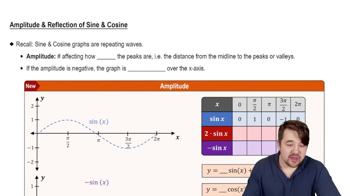Here are the essential concepts you must grasp in order to answer the question correctly.
Amplitude
Amplitude refers to the maximum height of a wave from its midline. In the context of trigonometric functions like cosine, it is determined by the coefficient in front of the cosine term. For the function y = 1/2 cos(3x + π/2), the amplitude is 1/2, indicating that the graph will oscillate between 1/2 and -1/2.
Recommended video:
Amplitude and Reflection of Sine and Cosine
Period
The period of a trigonometric function is the length of one complete cycle of the wave. It can be calculated using the formula Period = 2π / |B|, where B is the coefficient of x in the function. For the given function y = 1/2 cos(3x + π/2), the period is 2π / 3, meaning the function completes one full cycle over this interval.
Recommended video:
Period of Sine and Cosine Functions
Phase Shift
Phase shift refers to the horizontal shift of the graph of a trigonometric function. It is determined by the expression inside the cosine function. For y = 1/2 cos(3x + π/2), we can rewrite it as y = 1/2 cos(3(x + π/6)), indicating a phase shift of -π/6 to the left, which affects the starting point of the wave on the x-axis.
Recommended video:
 Verified step by step guidance
Verified step by step guidance Verified video answer for a similar problem:
Verified video answer for a similar problem:



 5:53m
5:53m